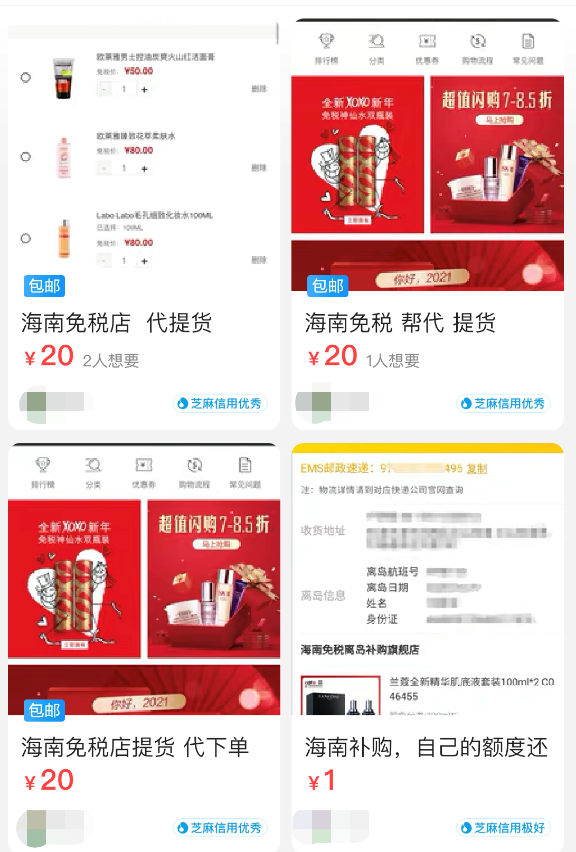Since the beginning of 2020, in order to help retail, tourism, and education, the Chinese Ministry of Finance (MOF) and State Taxation Administration (STA) and the local government have announced tax reliefs and measures to support related enterprises and citizens. China’s VAT tax incentive policies are set in place to boost domestic tourism and spending.
In February 2020, MOF issued circular tax policies, including value-added tax (VAT) incentives, to support businesses affected by the COVID-19 pandemic. In July, a new offshore duty-free policy in Hainan island was released to promote the development of the Hainan Free Trade Port and the construction of Hainan Tourism Island, which stimulates domestic tourism.
A string of tax incentive policies in China help domestic tourism recover

Source: Sina.com; a scenic spot crowded with tourists during 2020 golden week.
According to the China Tourism Academy, due to the impact of the epidemic, the annual domestic tourism revenue was expected to drop by 20.6% in 2020, with a reduction of 1.18 trillion yuan. While a survey showed that 71.5% of respondents said they would like to travel after the epidemic ended, and 20.7% said they would travel as soon as the epidemic ended.
The 2020 Chinese Golden Week witnessed the enthusiasm of people traveling during a stable period of few COVID-19 cases. Millions of Chinese tourists were spending on domestic travel, with shopping included. Meanwhile, thanks to the tax reduction policy, offshore duty-free sales in Sanya, Hainan, increased more than 200% compared to last year’s golden week. It also brought more than 443,000 passengers to Hainan airport.
In addition to the duty-free stores, some tourist attractions have also created new tour services and programs through the VAT tax refund to attract tourists. In Wugong Mountain, Jiangxi province, the local company used over 6 million yuan of VAT refunds to build the new viewpoint “Mirror in the Sky”, which has become a hot attraction on the internet.
China’s VAT tax incentive policies provide tourism companies with savings in operating costs and a buffer period during this special pandemic.
Duty-free and zero tariff policies make Hainan popular among customers and enterprises

Source: Xinhuanet. Tourists shop at a duty-free shopping mall in Sanya, Hainan Province
The exemption of VAT and consumption tax on duty-free items has led to an obvious consumption boost in Hainan. From the implementation of this new policy on July 1 to December 31 2020, the average daily sales exceeded 120 million yuan, an increase of more than double from 2019. And actual sales for the whole year were over 32 billion yuan, according to an Hainan government press release on January, 11, 2021.
The duty-free purchasing allowance increased from RMB 30,000 to RMB 100,000 per person, and the product categories rose from 38 to 45, including jewelry, watches, cosmetics, health products, tablets and so on.
Expect for the offshore duty-free policy, the “zero-tariff” product lists for Hainan Free Trade Port was officially released on December 1, 2020, including raw and auxiliary materials, transportation and yachts. For example, the tax cost on an imported yacht in Hainan can be reduced by 38%, that is, 10 million yuan yacht will pay 3.8 million yuan less tax. The zero-tariff policy is conducive to saving operating costs and capital costs of enterprises and benefits the development of variable industries like manufacturing, transportation, and tourism.
China’s VAT tax incentive policies have led to the growth of daigou
The duty-free boom in Hainan has also spread to daigous. Daigou (代购), referring to surrogate shopping, is when an individual or a syndicated group of exporters outside China purchases commodities for customers in China. According to Xinhuanet, the size of the overseas surrogate shopping market reached 260.1 billion yuan in 2018. But since daigou is related to tax evasion and avoidance, it is still a grey zone in Chinese laws.
Because of duty-free policy, the prices of some duty-free goods are lower than Japan, South Korea, and other markets, plus the pandemic influence of international logistics, Hainan obviously becomes a hot destination for daigou.
Some tourists leave Hainan before using up all their duty-free credits. In order to make up the regret and also to exchange the rest credits for money, some people began to “sell credits” on the Chinese second-hand platform, Idle Fish.

Source: Idle Fish. The search result of “Hainan daigou”. The price of surrogate shopping is from 10 to 20 yuan
Some government officials commented that “if we let the surrogate shopper earn the benefit, it changes the original intent of the duty-free policy, and disrupts the normal development of the market.” While some local citizens believe, to a certain extent, it is a way to solve Hainan’s employment and earn some extra money.
In fact, some critics think the open tax incentives policy in Hainan is a premature decision in the urgent situation, because currently, many related industries in Hainan are still in development and have scaled yet. Tax policies can address some problems but the business environment and tourism services are also important.
Learn something new? Stay updated on the Chinese market by following our WeChat, scan the QR code below, or subscribe to our newsletter

Learn more about Chinese duty free consumption
Listen to over 100 China entrepreneur stories on China Paradigms, the China business podcast
Listen to China Paradigm on Apple Podcast






